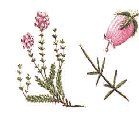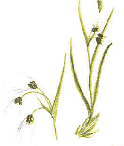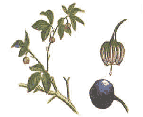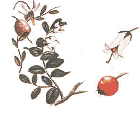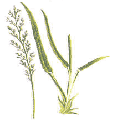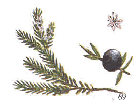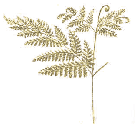The underlying geology of mudstones of the study area cause the soils to be peaty, supporting the growth of Siliceous/Acid vegetation.
A typical upland transect is shown below, green labels show the typical species found in each area, upper-case terms describe the soil conditions at each location on the transect.
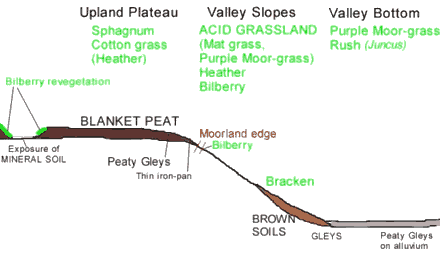
This typical transect produces four main moorland habitats as described below. Exact composition of species in any location is dependant on topography, relief, soils, anthropogenic factors etc.
| Vegetation | Topography | Soils |
|---|---|---|
| 1. Cotton grass moor - E4 | Highest slopes, up to altitudes of 600m | Wet/saturated, ill-drained, thick peat cover. |
| 2. Bilberry moor - E3 | Moderate to steep gradients on valley sides, mainly with underlying gritstone rocks. | Dry, thin peat |
| 3. Heather Moorland - E2 | Very gentle slopes, often with an underlying shale geology. Up to altitudes of approximately 450m. N.B. This does not apply to heather moors in Torside, where heather communities can be found clinging to steep valley sides - this is type D1, Acid Dry Heath | Well drained, relatively thin peat |
| 4. Acid grassland - B5 | Slightly higher & moderate steep slopes | Moist, thinner peat |
The codes (E2, B5 etc.) refer to the Dark Peak ESA Habitat Classification produced by the Farming and Rural Conservation Agency (FRCA) of MAFF (now DEFRA).
Dry Bog (e.g. E2, E3, E4)
- Is bog dominated by dwarf shrubs such as heather, bilberry or crowberry, or Hair-tail cotton grass.
- It is found on 0.5m or more of peat.
- It is species poor and sphagnum is absent.
Heath (e.g. D1, D2)
- Is made up of more than 25% dwarf shrubs growing on mineral soil,
- or peat less than 0.5m thick.
- It is relatively species rich.
1. The cotton grass moorlands
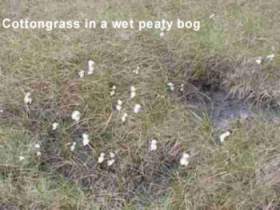
- Intact peat moors at high altitudes (up to 600m) are nearly all dominated by cotton grasses (Eriophorum) where peat growth is very slow.
- The dominant cottongrass found in the Dark Peak is hare's-tail cotton grass (Eriophorum vaginatum), but also with variable quantities of of the common cottongrass (E. angustifolium).
- Cottongrasses are found in on thick, acidic, saturated blanket peat in upland areas, often in and around acidic surface pools and bogs.
- They are the often the exclusive species in upland "mosses" (the local term for cottongrass moors), bilberry (Vaccinium myrtillus) and crowberry (Empetrum nigrum) occurring in the drier areas and wavy-hair grass (Deschampsia flexuosa) on drier tussocks.
- The very few species of mosses and liverworts that can survive the waterlogged conditions have been restructured in distribution by atmospheric pollution.
Cotton grass and peat erosion
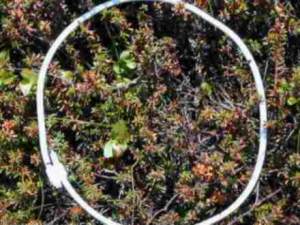
- Erosive forces have caused the dissection and drying of extensive areas of peat.
- The degeneration of cottongrass moorlands causes further drying of the peat, stimulating the resultant loss of the majority of hydrophilous (water loving) species.
- This encourages the spread and replacement of species adapted to drier conditions such as crowberrry, cowberry (Vaccinium vitis-idaea), bilberry, Mat-grass (Nardus stricta) and heather (Calluna vulgaris).
- The pure cottongrass moorlands are becoming increasingly rare.
- The replacement vegetation is bilberry moorland with localised crowberry clusters and cloudberry (Rubus chamaemorus).
Bilberry, crowberry and cowberry have shallow rooting systems which allow them to colonise the dryer surface layers of the eroded peat.
2. Bilberry Moorlands

The occurrence of bilberry is often a sign of blanket peat degradation as it prefers drier, thinner peats at the moorland edge or the sides of gullies.
Abundance of bilberry increases after burning (it has deeper roots that remain undamaged by the fire) and is often co-dominant with heather and Wavy Hair-grass in drier conditions, forming a rich brown-purple colour in spring.
3. Heather Moorlands
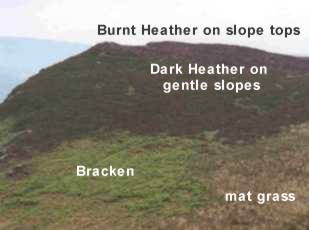
These are found over gentle slopes on low gritstone areas below the cottongrass blanket bogs. Heather (also called Ling) (Calluna vulgaris) cannot survive the deeper, wet peats and mostly prefers dryer, lower areas.
Heather moors are a managed system, maintained mainly for grouse shooting and sheep farming.
The heather is burnt regularly to maintain a mixture of mature shrubs required by the grouse for cover, and young shoots on which the grouse feed.
4. Acid Grasslands (siliceous grassland)
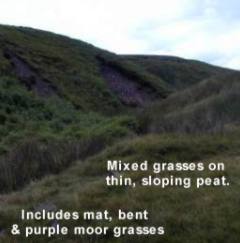
- These occur over relatively thin mineral soils with a thin peat layer, so are often found on valley sides.
- Acid grasslands are dominated by purple moor-grass (Molina caerulea) and mat-grass.
- The species composition of the siliceous grassland is determined strongly by the varying conditions of soil moisture, geology and altitude.
- Sheep's fescue (Festuca ovina) and common bent grass (Agrostis capillaris) occurs on well-drained and not excessively acid soils.
- Purple moor-grass occurs on gentle, wet slopes over shale areas where peat is 15-25cm deep. It is found in tussocks in damp hollows or as vast swards across damp pastures.
- Wavy hair-grass prefers steep slopes over shallow podzolic soils but is also found mixed with other species in many different conditions, often on outwashed and eroding peat margins over gritstone areas.
